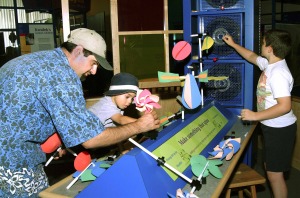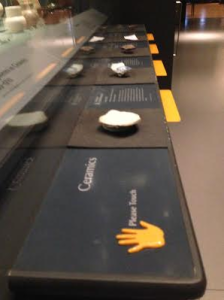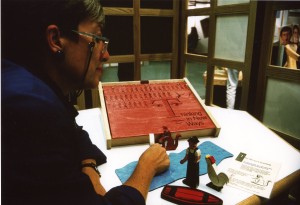The museum blogosphere in the past few weeks has been filled with postings related to the work of museum educators and the role of museums as educational institutions. Rebecca Herz has posted a number of articles and interviews with teachers and museum educators on her blog Museum Questions. Rebecca is examining from many angles the complicated connections between museums and formal education, as well as museums’ roles as informal environments for learning. UK museum blogger Nicole Deufel recently asked whether museum interpreters should be accredited teachers, as some of her colleagues maintain. Nicole defends the unique role of museum educators in introducing visiting students to experiences other than those provided by formal education environments and methods. And Washington Post critic Philip Kennicott raised lots of hackles in the museum field when he opined about how people should experience exhibitions and works of art, at the same time dismissing the work of museum educators. Kennicott’s ideas and the subsequent responses are ably described and analysed by Ed Rodley in two recent posts on Thinking About Museums.
I believe that all of this discussion is important and useful. The work of museum educators is often forgotten or devalued (witness the Kennicott column) despite the fact that the central purpose of museums as educational institutions has gained importance in both museum literature (see ICOM and AAM definitions of and documentation on role of museums) and in the mind of the general public. The above posts explore so many aspects of what is essentially a discussion of the museum experience–and educators’ contribution to it–that it is hard to know where to begin to comment. But I do see a couple of threads I would like to tease out.
One common theme is the continuing view of museums as places of teaching–whether it be of thinking skills or of museum content–and the accompanying use of classroom techniques by docents, museum teachers, or outside consultants. These approaches run the gamut, from traditional methods such as the use of museum classroom-like spaces and guided tours linked to specific curriculum goals, to more open ended techniques, such as Socratic questioning or group activities in the galleries. The discourse and mental models of formal education predominate. (See Herz’s interviews with Bown, Bowles, and Everett and Deufel’s post.)
Another thread is the view of museums as places of engaged experience, where learning occurs because spaces and exhibits have been designed to encourage it, and interpretive staff are there to encourage and facilitate. The focus is on providing students with experiences and ways of interacting with museum content that don’t happen in the classroom. (See Herz’s interview with Garcia and Deufel’s post again.)

Visitors are challenged to create whirligigs in the Invention at Play exhibition developed by the Lemelson Center at the Smithsonian’s National Museum of American History and the Science Museum of Minnesota. Museum educators were involved in all aspects of development, working with exhibit developers, designers, inventors, and historians. Educators also developed teacher and family materials and programs. Photo courtesy of NMAH.
While I spent much of my career as a museum educator happily operating within the first paradigm,(so I know why museums operate this way and how it important it is to their financial sustainability) I have come gradually to the conclusion that this model has its limitations. The role of museum educators is being expanded in many museums, and this needs to continue throughout our field.
Museums are so much more than resources for the formal educational system. Yet they often justify themselves almost exclusively, especially to politicians who control funding, in terms of their contributions to STEM and STEAM success. There is no doubt that exhibitions and museum programs provide all kinds of enrichment to students, but as school visitation to museums continues to diminish around the country, and as students continue to graduate and succeed even without museum visits, defending museums as essential to school learning seems short-sighted. As the school system narrows what it considers to be success (eliminating art, drama, music, field trips, etc) museums should ponder the wisdom of squeezing themselves into ever smaller curricular slots in order to attract and serve school groups.
The tours, manuals, workshops, and other resources and approaches developed by museum educators over the years have enhanced and enriched many a museum visit. I am not advocating an end to these practices, which are both valuable to visitors and rewarding to the the educators who create them. However, following the warning against keeping all your eggs in one basket, I believe it is important for museum education departments to budget an increasing amount of time and energy to shaping directly the creation of that which remains central to the museum experience: exhibitions. Educators already have many of the skills that exhibition teams require especially as they develop more participatory experiences. Here are just a few:
– understanding of human development, stages of learning
– understanding of accessibility guidelines
– experience in working on the floor with visitors; thus able to assist with testing and prototyping exhibits and text with visitors at various stages.
All of these skills and abilities of museum educators can be made available to museum exhibition creation through the development of an interpretive plan, about which I’ve written in earlier posts.

The British Galleries at the V&A in London were developed using a comprehensive interpretive plan on which curators, designers, and educators collaborated. Educators led the development of the plan. Here visitors are encouraged to touch examples of ceramics displayed in case above. Photo by Colleen Dilenschneider.
Tying the role of a museum too closely to its work with schools may narrow the public understanding of museums as educational institutions at their very core, not just in their contribution to formal education. When museum educators’ roles are limited to gallery teaching or to development of school programs and materials, this divorces them from involvement in the direct creation of the exhibition experience. From my experience in working in museums, positions most closely identified with the exhibition enterprise often take their power and prestige in the organizational hierarchy from this proximity.
It’s my view that the “something different” that museum educators should consider is less about fine tuning programs for schools and teachers and more about exploring with their administration and staff the very important contributions they can make to helping the museum to create exhibitions that are visitor-friendly and engaging for the multi-generational groups that are the staple of museum visitation. Thanks again to Rebecca for posing the questions that got this discussion going.

One of 10 Discovery Boxes developed by museum educators in collaboration with Ontario Science Centre exhibit developers and cognitive researchers for the Psychology Exhibition in the 1990s. Photo courtesy of APA.
If you are reading this on email, and wish to comment or subscribe, please click on http://www.museumcommons.com.